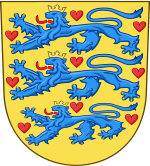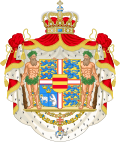- Canute VI of Denmark
-
Canute VI 
The seal of Canute VI, dating from the 1190s, is the earliest known example of the coat of arms of Denmark. The only known copy of this insignia was discovered in Schwerin, Germany in 1879. The king's closed crown differs from the open crowns shown on the seals of his successors.[1] King of Denmark Reign 1182–1202 Predecessor Valdemar I the Great Successor Valdemar II the Victorious Consort Gertrude of Bavaria Full name Canute Valdemarsen House Estridsen Father Valdemar I Mother Sophia of Minsk Born c. 1163
12 November 1202 (aged 38–39)Burial St. Bendt's Church, Ringsted Religion Roman Catholicism Danish Royalty House of Estridsen 
Valdemar I the Great Children Sophia, Countess of Orlamünde Canute VI Maria Valdemarsdatter Margaret Valdemarsdatter Valdemar II the Victorious Ingeborg, Queen of France Helena, Lady of Lüneburg Richeza, Queen of Sweden Illegitimate Children Christopher, Duke of Schleswig Canute VI Canute VI (1163 – 12 November 1202) was King of Denmark (1182–1202). Canute VI was the eldest son of King Valdemar I and Sophia of Polotsk.
Life
Canute VI was proclaimed King of Denmark at the Urnehoved Assembly (Danish: landsting) and subsequently at the other assemblies throughout Denmark. He immediately faced a peasant uprising in Skåne. The peasants refused to pay Bishop Absalon's tithe. They met at the Skåne Assembly and chose Harald Skreng, one of Canute friends to represent them to the king to plead their case. The king refused to hear Skreng out and began to gather an army to teach the peasants their place. Before the king could muster his army, the nobles of Halland and Skåne cobbled together their own army and defeated the peasants in a bloody battle at Dysjebro. Canute arrived with his army and proceeded to teach the peasants a lesson with fire and sword. Canute was so relentless that Bishop Absalon begged the king to desist.
Emperor Frederick Barbarossa had compelled Canute's father to acknowledge him as overlord, and in 1184 Barbarossa sent a messenger to Canute requiring him to acknowledge the emperor as his liege. Canute failed to respond, so the emperor sent a second messenger threatening the emperor's wrath if Canute failed to acknowledge his liege lord. Bishop Absalon replied to the messenger on behalf of Canute. "Canute is as free a king as the emperor. He has as much right to Denmark as the emperor has to the Holy Roman Empire, and so the emperor should expect no allegiance from this place."[2]
The emperor flew into a rage when he received Canute's reply, but because of troubles farther south, ordered his vassal, Bugislaw of Pomerania to invade Denmark. Count Bugislaw, recognizing a great opportunity quickly gathered 500 ships. The first notice of the pending invasion came from Chief Jærmer of Rügen who sailed to Zealand to give warning. The king was in Jutland, and so it was left to Bishop Absalon to order every available ship from Zealand, Funen and Skåne to meet him in six days. Absalon sailed for Rügen with his fleet and waited for Bugislaw to show up. When the enemy failed to appear, Absalon sent out scouts to bring word when the Pomeranian fleet arrived. He ordered his men to go ashore so he could celebrate mass on Second Easter Day. In the middle of services, one of the scout ran into the church shouting that the enemy had been sighted through the fog. "Now will I let my sword sing the mass to the praise of God!" exclaimed Absalon as he set aside the altar implements.[3]
The Danish fleet weighed anchor and sailed through the fog toward the Pomeranians. Bugislaw's fleet saw nothing of the Danes until they were close enough to hear their war cries. Fear swept through the Pomeranians, and they tried to row away, but they were in such close quarters that the ships couldn't turn. The men panicked and began jumping from ship to ship which caused eight of them to flounder. The Danes threw themselves onto the ships to plunder them when Absalon shouted that they should leave the goods and go after the ships. Few complied and with just seven ships, Absalon routed the entire Pomeranian fleet, capturing 35 enemy ships. Absalon sent Bugislaw's own great tent to Canute, who was still on in Jutland. With Bugislaw's defeat the emperor gave up, for a time, his attempt to rule Denmark.[4]
Canute ordered two invasions of Pomerania and in 1185 forced Bugislaw to acknowledge Canute as his overlord. From that time until 1972 the Kings and Queens of Denmark used the title "King of the Wends" as part of a lengthy list of duchies, counties, and regions ruled by Danish monarchs through the centuries. Contemporary sources describe Canute as an earnest, strongly religious man. Canute personally led a crusade against the pagan Estonians in 1197.[5]
Canutes' younger brother Valdemar, Duke of Southern Jutland, was just twelve years old when his father died and Bishop Valdemar of Schleswig was appointed regent until Valdemar came of age to rule. Bishop Valdemar was ambitious and began gathering support of German nobles to support him against the king. Disguising his own interests as young Valdemar's, Bishop Valdemar plotted with Count Adolph III of Holstein to overthrow Canute and set himself up as king. When Valdemar was selected as Archbishop of Lund, he spoke openly of his plans. Young Duke Valdemar asked to meet with Bishop Valdemar at Åbenrå in 1192. When the powerful bishop arrived, young Valdemar ordered his men to arrest the bishop and sent him in chains to Søborg Tower in North Zealand for the next 13 years. In 1199 Count Adolph tried to raise opposition to Valdemar in southern Denmark, so the young Duke attacked Adolph's new fortress at Rendsburg. Valdemar defeated Adolph's army in the Battle of Stellau in 1201 and captured the count who spent the next three years in Søborg Tower with the archbishop. In order to buy his freedom, the count had to turn over all his lands north of the Elbe to Duke Valdemar in 1203.[6]
At his death Canute ruled from the Elbe north to the Arctic Circle and east as far as Estonia and Sweden. Denmark had almost reached its largest extent. Then without warning, Canute's friend and advisor, Bishop Absalon died. He had been one of the most important figures in all of Danish history. Absalon was buried beside his father in Sorø church. His epitaph reads "a good and brave man". Just a year later Canute died suddenly at age 40.[7]
Canute married Gertrud, a daughter of Duke Henry the Lion of Saxony. She did not bear him any children.
Ancestry
Ancestors of Canute VI of Denmark 16. Sweyn II of Denmark 8. Eric I of Denmark 17. Gunhild Sveinsdotter 4. Canute Lavard 18. Thrugot Ulfsson Fagerskind 9. Boedil Thurgotsdatter 19. Thorgunna Vagnsdatter 2. Valdemar I of Denmark 20. Vladimir II Monomakh 10. Mstislav I, Grand Prince of Kiev 21. Gytha of Wessex 5. Ingeborg of Kiev 22. Inge I of Sweden 11. Christina Ingesdotter of Sweden 23. Helena 1. Canute VI of Denmark 24. Vseslav of Polotsk 12. Gleb Vseslavich, Prince of Minsk and Polotsk 6. Volodar, Prince of Minsk and Hrodno 26. Yaropolk Izyaslavich 13. Anastasia Yaropolkvna of Turov and Lutsk 27. Kunigunde of Meissen 3. Sophia of Minsk 28. Władysław I Herman 14. Bolesław III Wrymouth 29. Judith of Bohemia 7. Richeza of Poland 30. Henry, Count of Berg 15. Salomea of Berg 31. Adelaide of Mochental References
 Media related to Canute VI of Denmark at Wikimedia CommonsCanute VIHouse of EstridsenBorn: circa 1163 Died: 12 November 1202
Media related to Canute VI of Denmark at Wikimedia CommonsCanute VIHouse of EstridsenBorn: circa 1163 Died: 12 November 1202Regnal titles Preceded by
Valdemar the GreatKing of Denmark
1182–1202Succeeded by
Valdemar II the VictoriousMonarchs of Denmark Early monarchs c.916–1412(Harthacnut) · Gorm the Old · Harald Bluetooth · Sweyn Forkbeard1 · Harald II · Cnut the Great1 · Harthacanute1 · Magnus the Good · Sweyn II · Harald III · Canute the Saint · Olaf I · Eric Evergood · Niels · Eric the Memorable · Eric Lamb · Sweyn Grathe / Canute V / Valdemar the Great · Canute VI · Valdemar the Victorious / Valdemar the Young · Eric Plough-tax · Abel · Christopher I · Eric Klipping · Eric Menved · Christopher II · Valdemar III · Christopher II · Interregnum · Valdemar Atterdag · Olaf II · Margaret I2
Palatinate-Neumarkt 1397–1448Oldenburg 1448–1863Christian I2 · John2 · Christian II2 · Frederick I · Christian III · Frederick II · Christian IV · Frederick III · Christian V · Frederick IV · Christian VI · Frederick V · Christian VII · Frederick VI · Christian VIII · Frederick VIISchleswig-Holstein-
Sonderburg-Glücksburgsince 1863Categories:- Danish monarchs
- House of Estridsen
- Burials at St. Bendt's Church
- 1163 births
- 1202 deaths
- Roman Catholic monarchs
Wikimedia Foundation. 2010.
